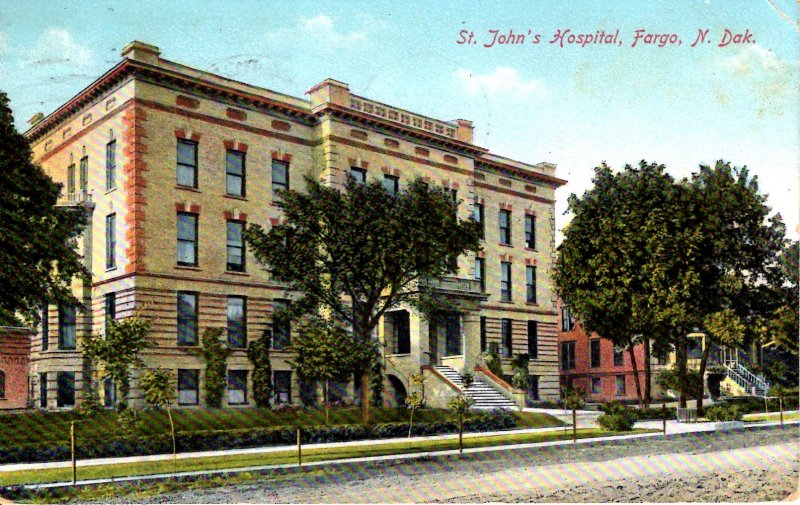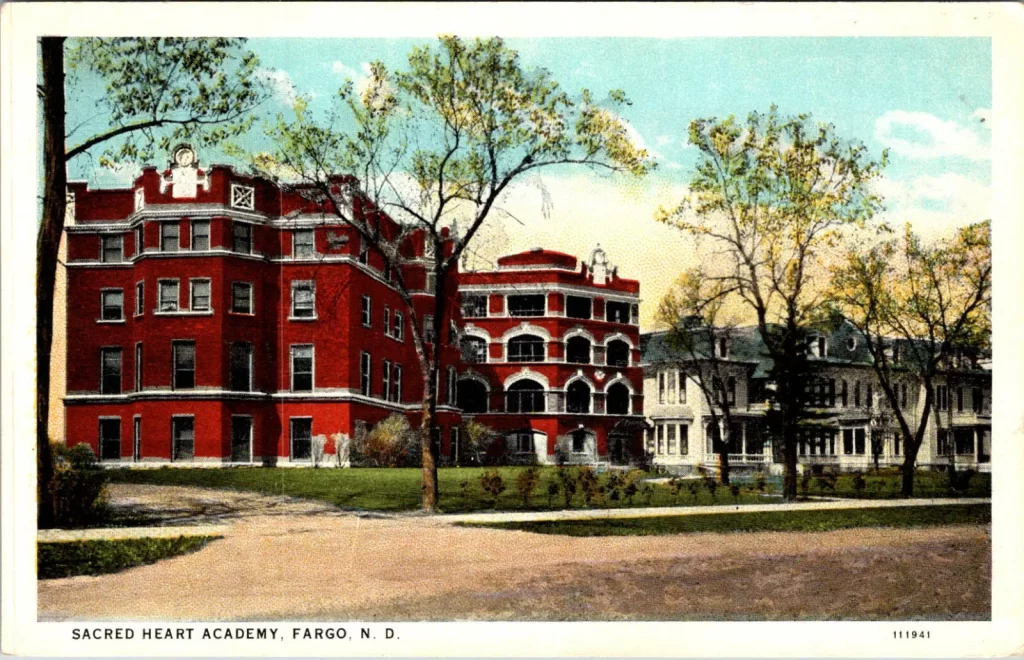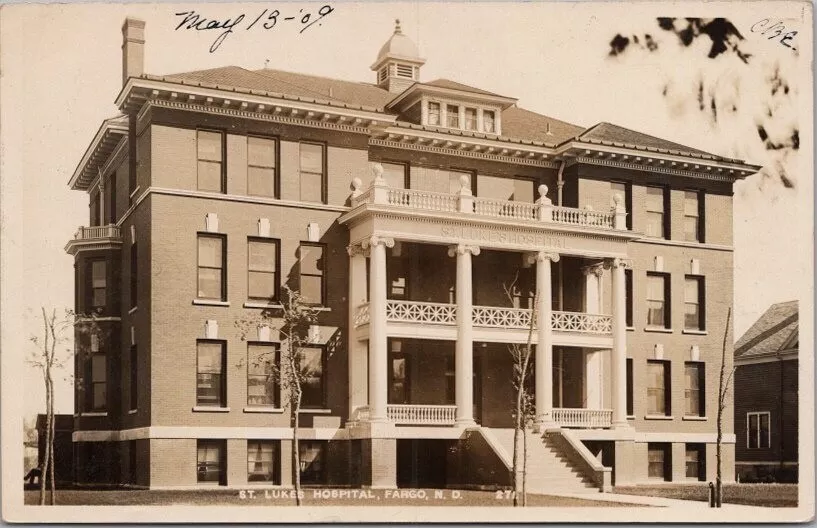Early Fargo hospitals played a crucial role in the development of the city’s healthcare system. St. John’s Hospital, established in April 1900 by six sisters of St. Joseph, began in Bishop Shanley’s former residence and expanded to a new facility in Island Park in 1904. The hospital featured modern amenities and a nursing school. Sacred Heart Academy, run by the Presentation Sisters, provided education for young women, with a focus on academics and personal development, and also included St. Aloysius School for boys. St. Luke’s Hospital, initiated by local Lutheran leaders in 1905, opened in February 1908 with a capacity of 50 beds, which was soon to be expanded. Additionally, the Fargo Infirmary of Osteopathy, established in 1897, offered specialized osteopathic treatments. These institutions collectively contributed to the health and well-being of Fargo’s residents.
St. John’s Hospital
In April 1900, six sisters of St. Joseph, all of them being experienced and trained nurses, opened a hospital in a modest way in the residence formerly occupied by Bishop Shanley. After three years of experiment on so limited a scale, their institution had proven itself so much a public necessity that they decided upon a new and spacious building, commensurate with all the demands of modern surgery and medicine. They accordingly set about the undertaking, with the result that on November 1, 1904, the present handsome structure in Island Park, the most beautiful portion of the city of Fargo, was formally dedicated. It has a nursing staff of fifteen sisters and many lay trained nurses have been added. Its grounds comprise about twelve acres, and in the center of this beautiful woodland stand the commodious and imposing hospital buildings. The city railway of Fargo and Moorhead passes within one block of the hospital doors. No more fitting site for an institution of the kind can be found in North Dakota. The building itself is entirely used for hospital purposes, the heating plant, lighting plant, laundry, and kitchen being in separate buildings. The ground floor of the hospital comprises six private rooms, two medical wards, surgical emergency dressing room, chemical laboratory, nurses’ dining room, linen closets, etc., also offices, reception rooms, and seven private rooms, all elegantly furnished by friends of the institution. On the first floor also are the hospital internes’ rooms. On the second floor are ten private rooms and one medical ward. The third floor has three private rooms and two surgical wards, a consultation and dressing room for surgeons, also an operating room and sterilizing room. In connection with the hospital, a training school for nurses is maintained. It requires a full course of three years for graduation. Each floor is in charge of a graduate sister nurse. The larger part of the patients cared for at St. John’s Hospital are surgical cases, about 15 percent only being medical patients. From the day of its completion to the present the rooms and wards of St. John’s Hospital have been in demand.
Sacred Heart Academy
Located in the most beautiful residence portion of the Gateway City is the Sacred Heart Academy, which is conducted by the good Presentation Sisters, and it is one of North Dakota’s most popular institutions for the education of young women. The grounds of this academy are large and afford ample facilities for outdoor exercise, while on every side the beauties of nature appeal to the students, whose minds respond to the elevating influences. Sacred Heart Academy occupies a large three-story structure, and is amply equipped and furnished for the accommodation of students. For careful and thorough training of young women there is no institution of learning in this country that is ahead of Sacred Heart. All the leading branches are taught and special attention is given to music, drawing, painting, stenography, and typewriting. The sisters pride themselves on their students; they show them the right way, and when they are graduated they have learned the greatest lesson of all lessons, which makes them good, pure, and lovely women. The enrollment at this institution is usually large. Many day pupils are taken in and they receive the same careful, painstaking, and motherly training as do those who board and live at the academy. In connection with Sacred Heart Academy is St. Aloysius School, which is a preparatory school for young boys. Its advantages are appreciated by parents and guardians and it has a large attendance. Tuition is reasonable. The directress of the Sacred Heart Academy will be pleased to furnish any additional information.
St. Luke’s Hospital
The following persons assembled at No. 10 Broadway, over Christiansen Drug Company’s store, March 22, 1905, to talk over the matter of building a Lutheran hospital in Fargo:
Dr. Nels Trounes
Lars Christiansen
Dr. Olaf Sands
W. O. Olson
Dr. C. Kachelmacher
Rev. A. O. Foukalsrud
A. A. Trovaten
S. Romsdahl
The matter was fully discussed and all present deemed it proper and advisable that such a hospital should be built. The next meeting was held May 23, 1905, in Aaker’s Hall, Fargo, when the organization was completed and the following gentlemen were elected as the first board of directors:
Rev. A. O. Foukalsrud
Lars Christiansen
Rev. S. Romsdahl
W. O. Olson
Rev. N. O. Grunden
Rev. K. Dalager
Dr. C. Kachelmacher
Rev. A. Wold
Judge A. G. Hanson
The name of the association was to be known as the Lutheran Hospital Association of Fargo, N.D. A stock company with $50,000 capital, par value of shares $25 each.
The hospital is located at the corner of Eighth Avenue North and Broadway, and has been in operation since February 1908. It has fifty beds and an addition of fifty more is planned for. It has been a great success from the start, being full of patients most of the time.
Fargo Infirmary of Osteopathy
This institution was established in 1897 and since that time has had a most successful career. They occupy a large building on Eighth Street for their infirmary. Drs. Bayse and de Lendrecie are the resident physicians and give the treatments personally.
North Dakota was the fourth state to recognize the practice of Osteopathy by legislative enactment. An attempt was made to prevent osteopaths from practicing in the state, and Mrs. Helen de Lendrecie, of Fargo, went before the legislature single-handed and pleaded for justice. As a result of her work an osteopathic bill was passed in the senate by a vote of 23 to 5, and in the house by 43 to 16. It became a law July 1, 1897. It was an exact copy of the Missouri law of March, 1897, except that section 1, was omitted. ((Booth, Emmons Rutledge, History of osteopathy, and twentieth-century medical practice, Cincinnati Press of Jennings and Graham, 1905.))



